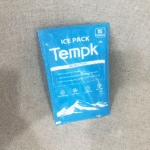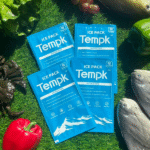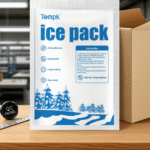L'expédition de marchandises périssables avec de la neige carbonique nécessite le strict respect des réglementations internationales de sécurité afin de prévenir les risques tels que l'accumulation de pression et l'asphyxie.. Compréhension comment étiqueter les paquets de glace carbonique selon IATA 954 garantit à la fois la sécurité et le respect de la réglementation. Ce guide fournit un processus détaillé, étape par étape, pour étiqueter correctement les emballages de glace sèche., assurer la conformité et réduire le risque de pénalités.
-
Pourquoi l'étiquetage de la neige carbonique est-il crucial pour la sécurité?
-
Quelles sont les exigences exactes de l'IATA 954 pour l'étiquetage sur glace carbonique?
-
Comment étiqueter correctement les paquets de glace carbonique pour éviter les pénalités?
-
Quelles sont les conséquences d'un étiquetage inapproprié?
-
Dernières tendances en matière d'emballage de glace carbonique pour 2025.
Pourquoi un étiquetage approprié des emballages de glace carbonique est-il essentiel?
L'étiquetage des paquets de glace carbonique est crucial pour la sécurité, conformité, et des transports efficaces. La glace carbonique est classée comme une marchandise dangereuse, et une mauvaise manipulation peut entraîner des accidents graves, comme une suffocation ou une explosion due à l'accumulation de gaz CO₂. Le respect des directives d'étiquetage appropriées garantit non seulement la sécurité du personnel, mais garantit également que votre envoi respecte les normes du transport aérien international., éviter les pénalités et les retards.
Principales raisons pour lesquelles l’étiquetage est important:
-
Sécurité: Prévient les accidents liés à l'accumulation de gaz CO₂, ce qui peut être mortel dans des espaces confinés.
-
Conformité: Garantit le respect de l’IATA 954 règlements, éviter les amendes et les retards.
-
Instructions claires: Fournit aux gestionnaires les informations de sécurité nécessaires.
Qu'est-ce que l'IATA 954 Exigence pour l'étiquetage de la glace carbonique?
Instruction d'emballage de l'IATA (PI) 954 est spécialement conçu pour le transport sûr de la neige carbonique. Il impose l'inclusion de plusieurs éléments d'étiquetage clés pour minimiser les risques pendant le transport aérien.. Voici une ventilation des exigences essentielles.
Éléments clés de l'étiquetage de l'IATA 954:
-
Numéro ONU et désignation officielle d'expédition:
Chaque emballage contenant de la neige carbonique doit être marqué:-
Et 1845 (Dioxyde de carbone, solide)
-
-
Classe de danger et étiquette:
-
La glace carbonique est classée sous Classe 9 (Marchandises dangereuses diverses), Et une classe 9 une étiquette de danger doit être apposée sur l'emballage.
-
-
Informations sur le volume de CO₂:
-
Afficher clairement le poids net de la neige carbonique (en kilogrammes ou en livres) et poids brut (y compris le contenu).
-
-
Instructions de manipulation spéciales:
-
La lettre de transport aérien doit indiquer « Dioxyde de carbone, solide, UN 1845" ainsi que des instructions de ventilation pour garantir que le gaz puisse s'échapper pendant le transport..
-
-
Exigences spécifiques aux compagnies aériennes:
-
Des formulaires supplémentaires comme le Déclaration de marchandises dangereuses peut être exigé par certaines compagnies aériennes.
-
Exemple d'un emballage de glace carbonique correctement étiqueté:
| Élément d'étiquette | Détails | Importance |
|---|---|---|
| Numéro de l'ONU | Et 1845 | Identifie la substance comme dangereuse |
| Nom d'expédition approprié | Dioxyde de carbone, solide | Spécifie la substance expédiée |
| Classe de danger | Classe 9 | Alertes sur diverses marchandises dangereuses |
| Poids net | 5 kg | Fournit des détails de manutention et des informations de transport |
| Notes de manipulation spéciale | Ventiler, Soyez prudent | Réduit le risque d’asphyxie ou de rupture |
Comment étiqueter correctement les emballages de glace carbonique?
Le processus d’étiquetage des paquets de glace carbonique est simple, mais l'attention aux détails est cruciale. Voici un guide étape par étape pour garantir que vos envois sont conformes à l'IATA. 954.
Processus d'étiquetage de glace carbonique étape par étape:
-
Préparer l'emballage:
-
Utiliser fort, conteneurs isothermes avec trous de ventilation pour permettre au gaz CO₂ de s'échapper.
-
-
Apposez l’étiquette de danger:
-
Placer le Classe 9 étiquette de danger sur le paquet, s'assurer qu'il est visible et intact.
-
-
Inclure le numéro ONU et le nom d'expédition:
-
Du même côté que l'étiquette de danger, afficher bien en évidence Et 1845 et Dioxyde de carbone, solide.
-
-
Marquez le poids:
-
Énumérez à la fois les poids net de la neige carbonique et du poids brut du colis, y compris le contenu.
-
-
Ajouter des instructions de manipulation spéciales:
-
Indiquez clairement «Glace sèche» et fournir instructions de ventilation.
-
-
Remplir la lettre de transport aérien:
-
Remplissez le Sur Waybill avec le nombre de colis, poids net par colis, et les instructions de manipulation nécessaires.
-
-
Examiner les exigences spécifiques aux compagnies aériennes:
-
Assurez-vous que tous les formulaires requis (Par exemple, Déclaration de marchandises dangereuses) sont terminés avant expédition.
-
Quelles sont les conséquences d’un étiquetage inapproprié?
Un étiquetage incorrect peut entraîner plusieurs pénalités et perturbations opérationnelles. Voici les conséquences potentielles:
-
Amendes: Les autorités peuvent imposer des amendes en cas de non-respect de l'IATA 954.
-
Retards: Les expéditions peuvent être retardées ou rejetées, affectant les produits sensibles comme les produits pharmaceutiques ou les aliments.
-
Confiscation: Dans les cas graves, les envois mal étiquetés peuvent être confisqués, entraînant des pertes financières.
2025 Tendances et innovations dans le transport de glace carbonique
Alors que l'industrie de la chaîne du froid continue d'évoluer, plusieurs tendances émergentes façonnent la manière dont la glace carbonique est expédiée:
Technologie de surveillance intelligente:
-
Capteurs de surveillance en temps réel intégré dans l'emballage pour suivre les niveaux de CO₂ et la température, améliorer l'intégrité des expéditions.
Emballage durable:
-
Utilisation croissante de écologique des matériaux d'emballage qui réduisent l'impact environnemental et minimisent les taux de sublimation.
Solutions d'étiquetage numérique:
-
La montée outils numériques et applications mobiles qui génèrent et suivent des étiquettes de glace carbonique conformes, réduire l'erreur humaine.
Questions fréquemment posées (FAQ)
Q1: Ai-je besoin d’une déclaration de l’expéditeur pour les expéditions de glace carbonique?
-
Une déclaration de l’expéditeur n’est pas requise si la neige carbonique est utilisée uniquement pour refroidir des marchandises non dangereuses.. Cependant, il est essentiel de compléter la lettre de transport aérien avec les détails nécessaires.
Q2: Quel est le poids maximum autorisé de glace carbonique par colis?
-
Le poids maximum autorisé par colis est de 200 kg pour avion cargo. Les avions de passagers ont des limites plus strictes de 2.5 kg par passager individuel.
Q3: Comment dois-je emballer de la neige carbonique pour le transport aérien?
-
Assurez-vous que votre emballage est ventilé et isolé pour permettre une libération sûre du gaz CO₂ pendant le transport. Ne pas utiliser de sacs ou de contenants scellés.
Conclusion
Un étiquetage approprié des expéditions de glace carbonique est un élément essentiel pour garantir le transport sûr et conforme des marchandises sensibles à la température.. En adhérant aux directives énoncées dans IATA PI 954, vous pouvez réduire le risque d'accidents, éviter des amendes coûteuses, et rationaliser le processus d'expédition. Restez toujours à jour avec les dernières réglementations et intégrez les avancées technologiques pour améliorer la sécurité et la conformité..
À propos du tempk
À Rotation, nous sommes spécialisés dans la logistique de la chaîne du froid, s'assurer que toutes les expéditions, y compris ceux avec de la neige carbonique, respecter les dernières règles de sécurité. Nos solutions d'emballage avancées et notre expertise réglementaire garantissent le transport sûr et efficace des marchandises périssables., minimiser les risques et maximiser la fiabilité.
Pour plus d'informations, consultez un expert Tempk dès aujourd'hui et assurez-vous que vos envois sont entièrement conformes aux normes IATA.
























